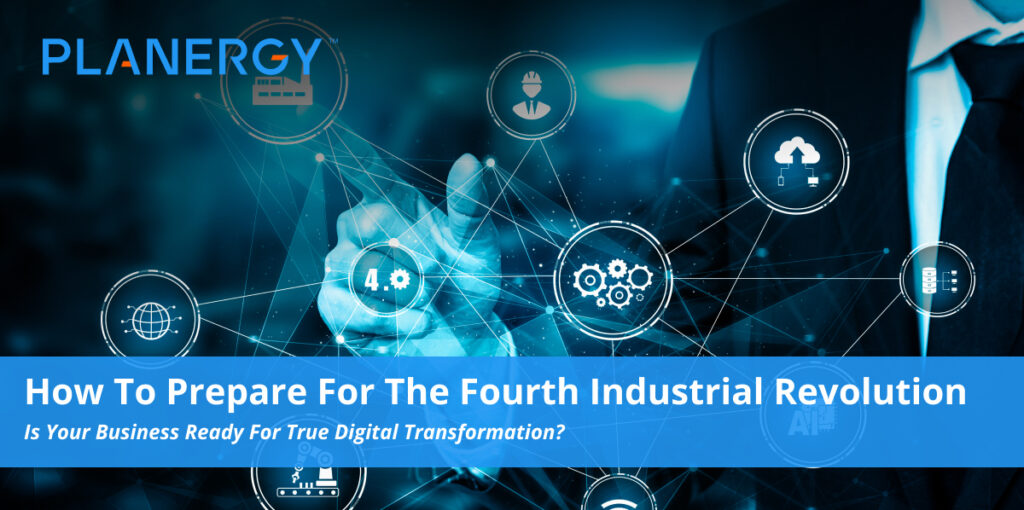From the dawn of bronze working to the birth of automation, advances in technology have always helped to shape the way humans live, play, and do business.
Today, the fourth iteration of the industrial revolution plays an increasingly important part in the ways organizations optimize themselves to compete more effectively–and helps define the paths they’re taking into the digital future.
But not every business is taking full advantage of new technologies; in fact, some may not even be aware of just how essential core concepts like digital transformation, business process automation, and continuous improvement are to their continued existence and success.
By learning how to prepare for the fourth industrial revolution, organizations can not only capture more value and savings from their existing processes, but develop a digital transformation strategy that will help them continue to compete, grow, and thrive in the years ahead.
Why Learning How to Prepare for the Fourth Industrial Revolution Matters
Like the three that preceded it, the fourth industrial revolution is defined by emerging technologies with the potential to fundamentally alter the way we live, work, and play.
Also known as Industry 4.0 and often abbreviated to 4IR, the fourth industrial revolution builds on its predecessors to incorporate advanced technologies that blend the physical and digital worlds:
The First Industrial Revolution (1760 – 1840)
The First Industrial Revolution introduced important concepts such as mechanization, steam power, and both industrialization and urbanization, producing and shipping goods at speeds never before seen and bringing the workforce in from the farms to the newly energized cities.
The Second Industrial Revolution (1870 – 1914)
The Second Industrial Revolution upped the ante, introducing true mass production via the assembly line.
Businesses were eager to adopt new technologies like the telegraph to communicate, collaborate, and compete more effectively.
The Third Industrial Revolution (1950s to the early 21st century)
The Third Industrial Revolution gave birth to the Internet, the earliest stirrings of machine intelligence, and important advancements in renewable energy. It also encouraged the development of tech tools that allowed humans to focus more on meaningful and strategic work and less on repetitive drudgery by streamlining tasks wherever possible.
The Fourth Industrial Revolution (Today)
The Fourth Industrial Revolution builds on these ideas and expands them, introducing tools like digitalization, deep data analytics, process automation, robotics, artificial intelligence (AI), and the Internet of Things (IOT) that further streamline workflows and give humans even more freedom to accomplish greater things–including the fusion of the biological and virtual worlds in which we live.
For businesses, 4IR is driven largely by digital transformation, and business leaders are investing heavily in both tech tools and worker education to ensure their organizations have the technical skill sets, problem-solving abilities, and strategic capabilities to ensure their digital transition is successful.
But without a clear understanding of the challenges brought by 4IR and the technologies that drive it, a clear roadmap to digital transformation, or the tools required to reach it, companies may find themselves resigned to history’s dustbin along with the buggy whips and butter churns of ages past.
The fourth industrial revolution will reach its full flower not under the guidance of today’s management using yesterday’s ideas, but tomorrow’s leaders finding novel ways to integrate, optimize, and refine all aspects of life in the digital and physical worlds to which they hold dual citizenship.
Key Challenges Accompanying the Fourth Industrial Revolution
When it was first described by Klaus Schwab, the founder and executive chairman of the World Economic Forum, the fourth industrial revolution was differentiated from its competitors not only by the technologies that define it, but its velocity, scope, and systems impact:
Velocity
Humanity is discovering new technologies and enhancing old ones at a rate never before seen in history. Technology is now advancing exponentially, rather than at a linear rate.
Scope
Digital transformation is disrupting nearly every industry across the global economy.
Systems Impact
A bigger, broader, deeper disruptive force requires swift and substantial modifications to personal and professional environments. Businesses need to understand and contextualize the role digital transformation has to play in their continued existence and growth, and identify and implement the tools they need to make those changes happen, whether in production, management, internal process controls, or all three.
Beyond these characteristics, navigating the fourth industrial revolution is also challenging for businesses for three other reasons:
The Future is Now.
Part of the overall thrust of digital transformation is a forward-looking, strategic mindset that seeks to establish practices that don’t just create savings or attract new customers today, but optimize internal systems and leverage data management to anticipate and compete in the market of tomorrow. Integration blurs the lines between home and office, work and play, and so these solutions must also seek to improve all areas of life, not just the bottom line.
Work is an Action, not a Location
In a world plagued by natural disasters and political conflict and dramatically altered by the COVID-19 pandemic, brick-and-mortar may go the way of horse-and-buggy. The sprightly, resilient business leaders of tomorrow are already integrating digital tools that make it possible to connect and collaborate without regard for location, devices, or even time zones.
Achieving healthy work-life balance, leveraging mobile accessibility, and enjoying full integration of software systems, Internet-connected devices, and multiple data streams to create a cohesive whole ripe for mining strategic insights and process improvements are no longer optional, but expected in the new normal.Youth in Bloom
Shockingly fast. Techno-fluent from birth. Focused on systemic integration, social responsibility, and issues that affect their lives, rather than just their livelihoods. The fourth industrial revolution will reach its full flower not under the guidance of today’s management using yesterday’s ideas, but tomorrow’s leaders finding novel ways to integrate, optimize, and refine all aspects of life in the digital and physical worlds to which they hold dual citizenship. It’s up to today’s business leaders to set the stage for this flowering by investing in the resources, training, and education required to empower those who will follow, as well as the technologies they can use to create even greater advancements in productivity, innovation, and profitability.
Sound daunting? It doesn’t have to be. With a proactive, strategic approach, the right tools, and a willingness to embrace digital transformation as a virtue rather than a necessary evil, you can ensure your organization is well positioned to thrive as you navigate Industry 4.0.
Preparing Your Company for the Fourth Industrial Revolution
Digital disruption is everywhere you look. The world’s largest video rental service is a software company (Netflix). The world’s largest bookseller?
Also a software company (Amazon). 3D printing and remote collaboration tools are upsetting the applecart in countless industries, from tabletop gaming to videoconferencing to software and product development.
Analytics turn Big Data into actionable insights that have given the world plant-based burger replacements, on-demand home delivery for groceries, and massive gains in efficiency, speed, and accuracy for countless business processes.
Tools like autonomous vehicles, AI-driven chatbots and process automation stand poised to forever alter the way we handle high-volume, repetitive tasks.
The digital and biological worlds are blending like never before, and now’s the time to upgrade your own systems by charting your course through the fourth industrial revolution with a few basic best practices:
Develop and Implement a Digital Transformation Strategy
Fail to plan, and you’re planning to fail. Evaluate your current capabilities. Identify the areas most in need of improvement and digital enhancement to protect your competitive capabilities.
Answer important questions like “What skill sets will our staff need to develop as we modify our workflows with tools like automation, artificial intelligence, and analytics?” and “What changes will have to be made in order to attract and retain team members who are digital natives?”
Develop a digital transformation strategy and then invest in the tools and training you need to ensure your organization can make it reality.
Invest in Education and Training
Your existing team members need training to take advantage of new technologies.
They might also need time and significant educational investments to help them make the cultural leap as well as the operational one.
But digital learning tools can also become part of your workflows, from employee onboarding through advanced training.
Understanding the what, why, and how of digital technologies helps your employees use them more effectively, use their skills and knowledge in novel ways, and keep them engaged as you continue to refine your business process management through automation, strategic planning, etc.
Choose the Right Digital Tools
Just as a chainsaw is better at felling a Sequoia than a butterknife, the digital tools you use can mean the difference between roaring success and utter failure.
Consider, for example, your procurement department.
Choosing a cloud-based, data-centralized solution like PLANERGY adds a number of Industry 4.0 tools to your kit and makes it easy to establish a foundation for digital transformation through:
- Optimized automation of repetitive, high-volume tasks like invoice processing, lowering cycle times and capturing more discounts.
- Human resources dedicated to strategic tasks like relationship building and innovation rather than data entry, chasing exceptions, or placating perturbed vendors.
- A centralized data management environment where all transaction data is captured and stored for easy access, review and analysis.
- Mobile-friendly, platform-agnostic access for all stakeholders, making it easier to connect and collaborate across not just offices but continents and time zones.
- Elimination of human error and inefficiency, along with productivity and profitability killers like approval bottlenecks, maverick spend, and inaccurate financial reporting.
- Full integration with your existing software environment.
- Advanced analytics for immediate and measurable improvements in supplier management, financial planning, strategic decision making, and employee morale.
- Value creation through reputational enhancements and socially responsible initiatives (e.g., going paperless not only creates savings and reduces your company’s environmental footprint, but improves public perception).
- Modularity and staged implementation that can be used to address immediate business needs and then expanded to the rest of the organization as budget, resources, and training permit.
- A more flexible work environment that allows for better work-life balance through remote access and meaningful work.
Join the Digital Revolution
From problem-solving to process optimization, the fourth industrial revolution bridges the digital and the physical while radically altering our relationship to both.
Taking the time to understand its power and investing in the resources you need to reach your goals for digital transformation will help ensure your business is ready to capture value and savings today while building a strong foundation for competing and thriving in the decades to come.




